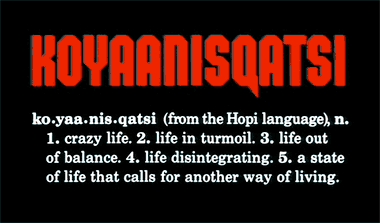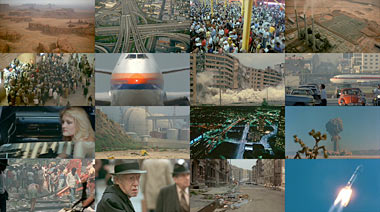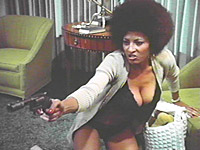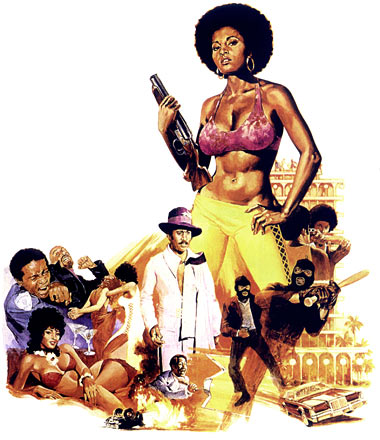
As suggested by the cinema-vérité sequences within Koyaanisqatsi, humankind--at least in the "western" world--has grown accustomed to its modern life of constant interaction, consumerism, queues and wage society. Its relationship to its own imagery has grown to embrace media that are overwhelmingly one-sided. Despite the existence of opinion polls, interactive websites, and the emergence of self-populated content in the form of weblogs and video sites, it is apparent that the masses do not control or produce its "mass" media. The majority of knowledge is disseminated through visual media, created and controlled by a limited number of corporations, which does not foster return communication.
Mobile imagery as seen on television and movie screens is fast-paced, lacking in information compared to print sources, and more likely to contain advertising, either of the corporate sort or the ideological. Even media intended to be dedicated to information delivery--such as television news--are carefully constructed to deliver sensation and attract viewers rather than to inform; its intent is a return in ad revenue rather than to provide its existing viewers with historical context. According to Chris Barker's Cultural Studies: Theory and Practice, Jean Baudrillard would call this "all-encompassing flow" of visual data a "hyperreality, in which we are overloaded with images and information" (Barker 207). The masses are lost in communication, lost in information that is targeted; because we cannot "separate reality from its statistical, simulative projection in the media" (Baudrillard 579), even the ever-growing accumulation of data cannot inform the viewer, instead creating a "new species of uncertainty [...] from information itself and even from an excess of information" (580). The data is manufactured, meaningless and motivated, and is not truly information, despite the time, effort, and sociological study expended to create it.
The technology involved--digital video, high-definition television, cable channels, the Internet--is seen both as favorable and detrimental. The ability to create and access media in such an unprecedented manner has the potential for "new electronic tribalism--an achieved transparency of information and communication" (Barker 577), yet its global capacity can be subject to Marxist criticism, chained to capitalistic desires and forced to "obey the dialectic of productive forces" (Barker 577). Because mass media is still directed mostly by corporations, there is a core element of hegemonic capitalism at odds with the concept of public interest. People have always created culture, yet so now do mass media corporations, creating a "terrain of conflict and struggle over meanings" (Barker 68); the public allows this defining of its own culture and perhaps may even assume it is accurate. Meaning is devalued in such a highly technological, information-delivery world; such controlled imagery is not reality, although it tries either to reflect it or simulate its own, and such simulation of reality promotes distractedness and consumerism. It is not the imagery itself that is to blame--although arguments can be made both for its "beneficial use" and its "manipulation"--since "there is no relationship between a system of meaning and a system of simulation" (Baudrillard 579). Koyaanisqatsi supports this, being itself a collection of simulation without meaning, without intent. It shows culture, it shows reality without culture, and is culture itself. It reflects but does not simulate or imitate.
Is it a sense of postmodernism, this blurring and redefinition of visual meaning? Is not Western society savvy enough to absorb the myriad of images, sort through its content and intent, and continue to be the base of its own reality? A primary aspect of postmodern culture is the bricolage, the "rearrangement and juxtaposition of previously unconnected signs to produce new codes of meaning" (Barker 202). For instance, in Koyaanisqatsi, a sequence of modern, glass-fronted office buildings becomes a series of aerial shots of a modern city, then to a succession of microchips and motherboards; the point at which the shift takes place is uncertain, and the visual parallel between the macro-buildings and the micro-chips is obvious. This insightful culture-referencing is a valid lens through which to interpret the world, yet it is doubtful that the corporate creators of mass media are interested in such; being creatures of capitalism, their goal is the conversion of inaction to consumer activity. Television informs movies, movies inform television, and both are now subjects of this new, dynamic presentation of spasming visual content; television is "at the heart of image production, and the circulation of a collage of stitched-together images that is core to a postmodern cultural style" (Barker 203). However, simply to remix and redefine in a postmodern manner is not sufficient to transfer power; to refer to other, past meanings does not necessarily urge one to act. Therefore the quickly-rendered imagery of the mass media is not a postmodern technique to influence thought, but an ocular conveyor belt meant to influence action.
Imagery is created, hence controlled. While "we have moved away from an economically determinist linear model" (Barker 56), the concept of culture-as-politics is still ingrained within the public mind; since "Capitalism is restless in its search for new markets, new raw materials, new sources of profit and capital accumulation" (Barker 180), the creators of mass media will always gear their content toward the continued culture of pro-capitalism. The imagery is exciting, suggestive of solution, and prods the viewer toward consumerism, but not to political action. The interaction between human and media becomes one-sided due to the latter's lack of informative content, and so the public allows the media to dictate culture: "if we cannot judge cultural products, then we have to accept that whatever is produced by corporations of the culture industries is acceptable because popular" (Barker 49). An uninformed public is desirable for a controlling power structure, and popular culture is built from this confusion and removal of will, a "state of stupor" resulting from a "radical uncertainty as to our own desire, our own choice, our own opinion, our own will" (Baudrillard 579). Rather than control via propaganda or force, the makers of mass media control via confusion. Postmodern-inspired imagery from a ruling superstructure blurs the sense of inequality--Baudrillard might say that the "continual flow of images [...] establishes no connotational hierarchy" (Barker 580)--confusing the public into feeling that all is well and going according to design. By seeming to offer much, mass media actually gratifies the desire to fail to act; the images are selected, edited, and devoid of provocative content except as an inducer of brief, sympathetic emotional response. The response itself is cathartic, but not enough to cause cultural action: "the masses are deeply aware that they do not have to make a decision about themselves and the world, that they do not have to wish, that they do not have to know, that they do not have to desire" (Baudrillard 585). Without a sense of historical perspective, and without media that informs, the public cannot compare what it sees to what it knows, or should know.
This causes a shift to consumerism--the only information comes from news or entertainment, and the only solution comes from advertising; whatever is lacking is artificial, and can be fulfilled by the same source (i.e., create a problem and solve it). The superstructure in the form of media-producing corporations and governments benefits globally, due to the public's unawareness of inegalitarian reality in the world. The promptings for consumption are "constantly introduced in the upper echelons of the social hierarchy, whence they diffuse downward through an extremely efficient system of consumption-oriented communications media" (Peet 566), despite its effects on the remainder of the world which suffers to support the consuming populace. In order to maintain a capitalist system, the "powerholders have a vested interest in preserving social inequality" (Peet 564), and so the rate of images and their appeal must be increased to maintain the public's desire to consume without awareness. There is not much turmoil in this, unless the public was more fully aware of its own lack of mobility or that of the less wealthy countries which support its own consumerism; even if the public is conscious of the injustices in the world, it does not "produce great social stress as long as all environments are improving" (Peet 569), and so the one-sided media continue.
Koyaanisqatsi highlights this seldom-shown disparity, showing scenes from many parts of existence, often unfamiliar--a ravaged street in New York after the 1977 blackout, a vast desert contrasted by a steadily-churning factory that colors its air, a sea of abandoned urban buildings with no apparent function except that they once housed people within their brick stomachs. Because there is no ideology, no drive, the scenes are simply visual, and so contain meaning as opposed to the produced imagery of television and movies; the meaning that can be culled from this scenery comes from the viewer, and is not embedded within the media itself. In this way Koyaanisqatsi counters the normally suppressive media deluge.
Much postmodern visual media is fast-paced, concerned with sound bites and explosions of interest and cultural appeal, bombarding the viewer with messaging or action. A movie or commercial may be filmed at a video game pace, its message hidden, subliminal, to be noticed only by the subconscious rather than by a discerning eye and mind. The massively-produced media "teaches us nothing at all" and have "rather restricted the limits of will and representation" (Baudrillard 584). In the case of action (such as the Transporter movies or the Bourne series, in which action is characterized by a staccato, unsteady flurry of images), this may be due either to an established hand-held filmography style or because the technology is still comparatively new, a case of "it can be done, therefore it is." Commercials are also carefully edited to transfer a maximum amount of visual advertisement within a set time limit, and so also tend to consist of this quick-cut style, where the eye is not allowed to rest upon an image before moving on. While Koyaanisqatsi predates this new imagery-barrage style of content delivery, it yet resists it; in showing long aerial shots of scenery, a human face puzzled or irritated at being filmed, or a cyclical sequence, for long minutes, Koyaanisqatsi allows the viewer to study the visuals without fear of looking away and losing what it shows. The attraction is due to the content and not the motion, and therefore the message is whatever the viewer slowly and with thought chooses to pull from it.
It seems an obvious principle that people need to be involved in their own creation of culture, "willing partners in the game of truth, in the game of information" (Baudrillard 582). There is a sense that the public of western culture has grown used to being fed its own reality, despite mass media's claim to support the public's desires. However, there are also signs that the "mass media" paradigm commanded by a capitalist power structure is beginning to falter, at least until it decides how best to adapt or reinvent itself. The newest forms of communicative technology is helping to bring this about; when anyone can create media, everyone will, and the production of media by the masses is a new culture in itself. For the time being, this technology is constrained to those lucky enough to live within a culture that provides it, but as with radio, then television, the Internet should prove to be the most democratizing of culture production--at least while it is still populated by the masses.
WORKS CITED
Barker, Chris. Cultural Studies: Theory & Practice. 3rd Ed. London: SAGE Publications, 2008.
Baudrillard, Jean. The Masses: The Implosion of the Social in the Media. Trans. Mary Maclean. New Literary History 16.3 (1985): 577-589.
Koyaanisqatsi: Life Out of Balance. Dir. Godfrey Reggio. MGM/UA, 1983. DVD. MGM, 2002.
Peet, Richard. "Inequality and Poverty: A Marxist-Geographic Theory." Annals of the Association of American Geographers 65.4 (1975): 564-571.

 Grover: I got your fix, don't you want your fix?
Grover: I got your fix, don't you want your fix?
